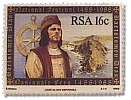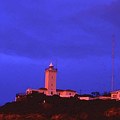- Home
- Community
- Business
-
Tourism
- Towns
- Accommodation
- Attractions
- Activities
- Gallery
- Maps
- Outings
- Pet-friendly accommodation
- S.A. Distance Chart
- Tide Chart
- Tourism Offices
- About Us
- Products
- User Menu

It is the fascinating history of Mossel Bay which grants the town its status as the historical capital of the Garden Route and one of the most historically significant towns in South Africa. Ancient stone-age fish traps and cutting edge fuel from gas technology; Khoi-San herders and European traders – the history of Mossel Bay is a microcosm of the history of South Africa herself.
Mossel Bay has always been associated with early European explorers. Bartholomeu Dias, the Portuguese Navigator, was the first European to discover the Southern tip of Africa while searching for a spice route to the East.

Having missed the Cape during a storm his first landfall was at Vleesbaai where he was prevented from going ashore, either by hostile Khoi cattle herders or by the rough surf, so he continued around the Point and landed (in what is now Munro's Bay) on 3 February 1488 (165 years before the first settlement in Cape Town). The Portuguese used this Bay for about 150 years until the Dutch Fleet forced them off the Indian Spice Route.
Dias named the bay AGUADA DE SAO BRAS, the Watering Place of St Blaize, as they landed here on the festival day of this Saint. The Spring is still here today but now no longer flows on the surface to the sea nearby although it was still flowing during the 1970s. Dias sailed eastwards along the coast as far as the Great Fish River where his crew refused to go any further. As was the custom he erected a padrao at his turning point before sailing Home. After years of research pieces of this padrao or Portuguese Cross were found at Kwaaihoek near the mouth of the Bushman's River and are now in safe-keeping at Wits University.

On his way back Dias discovered the Cape and named it Cabo de Boa Esperanza, Cape of Good Hope, and not Cape of Storms as is believed. Nine years later, in 1497, Vasco da Gama landed in the Bay. He traded a red cap and some bangles for an ox with “the little brown men on the beach”, possibly the first barter commercial transaction on the Sub-continent.
In 1500, Pedro d’Ataide sought shelter here after losing much of his fleet in a storm. He left an account of the disaster in an old shoe which he suspended from a milkwood tree near Da Gama’s spring. Incredibly, the report was found by another explorer, Joao da Nova in 1501 – and the tree, now a national monument, has served as a kind of a postal clearing house ever since.

A Portuguese Captain, Joao Da Nova, was presumably responsible for the famous Mossel Bay Stone, which has the inscription 1500 or 1501. The Stone itself is housed in the SA Museum in Cape Town but a cast can be seen in the Cultural History Museum in Mossel Bay.
But Mossel Bay’s history goes back many thousands of years which explains the presence of our many archaeological sites. The early seafarers found 3 tribes here, the Gouriqwas, the Outeniqua or Attaqwa, and the San. The Khoi and San are both believed to be descendants of early man in Africa. The San were hunter gatherers, while the Khoi, also called Strandlopers, were herdsmen and fishermen. They kept cattle for pack animals and for riding on. The Khoi possessed a good knowledge of healing herbs and were often called upon to help sick sailors left in their care.
If you want to explore our history, our numerous museums provide a fascinating look back in time; more than just dry exhibition rooms, they’re alive with the absorbing stories of our people and their cultures.